Task Force 1-41 Infantry
Task Force 1-41 Infantry was a U.S. Army heavy battalion task force which took part in the Gulf War of January – March 1991. Task Force 1-41 Infantry was the first coalition force to breach the Saudi Arabian border on 15 February 1991 and conduct ground combat operations in Iraq engaging in direct and indirect fire fights with the enemy on 17 February 1991.[1] It was the spearhead of VII Corps.[2] It consisted primarily of the 1st Battalion, 41st Infantry Regiment, 3rd Battalion, 66th Armor Regiment, and the 4th Battalion, 3rd Field Artillery Regiment all being part of the 2nd Armored Division (Forward), based at Lucius D. Clay Kaserne, 24 kilometres (15 mi) north of Bremen, in the Federal Republic of Germany.[3][2] Task Force 1-41 was commanded by Lieutenant Colonel James L. Hillman.[4]
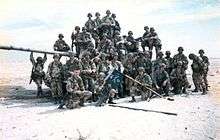
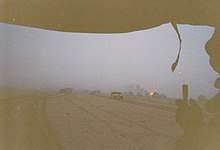
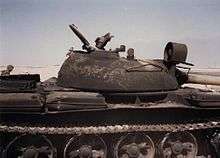
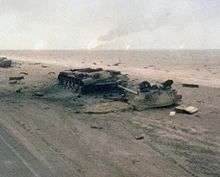
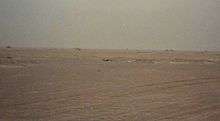

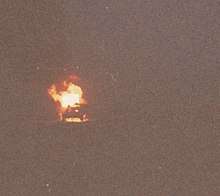
Organization
Task Force 1-41 Infantry comprised the following units:[5][6][7]
- Headquarters and Headquarters Company (HHC), 1st Battalion, 41st Infantry
- Company B, 1st Battalion, 41st Infantry
- Company C, 1st Battalion, 41st Infantry
- Company A, 3rd Battalion, 66th Armor
- Company B, 3rd Battalion, 66th Armor
- Company D, 317th Engineer Battalion
- Company D, 9th Engineer Battalion
- 3rd Platoon, Battery C, 2nd Battalion, 3rd Air Defense Artillery
- Two Ground Support Radar sections
- Fire Support Element, 4th Battalion, 3rd Field Artillery
- System Support Team, 498th Support Battalion
History
Formation
The 2nd Armored Division (Forward) arrived in Saudi Arabia in early January 1991, with 1-41 Infantry arriving on 8 January. After arrival in Saudi Arabia, 1st Battalion, 41st Infantry, was task organized (effectively merged in parts) with 3rd Battalion, 66th Armor Regiment.[8] This 'task organization', routine before combat, was designed to ensure that infantry and armour were present in balanced organizations so that they could provide mutual support. The task force's higher headquarters, 3rd Brigade, 2nd Armored Division, was itself attached to the 1st Infantry Division (Mechanized) to make up for a missing brigade of that division.[9] The brigade became known as Task Force Iron.[10] It would become the spearhead of VII Corps.
The 1st Battalion, 41st Infantry Regiment was equipped with M2 Bradley infantry fighting vehicles and formed part of the 2nd Armored Division (Forward). The other combat battalions of the brigade were the 2nd and 3rd Battalions of the 66th Armor Regiment (equipped with M1A1 Abrams tanks) and the 4th Battalion of the 3rd Field Artillery Regiment (equipped with M109 howitzers).[11] During exercises the battalion regularly exchanged combat elements with the other combat units in the division, with B company of 3-66 Armor being frequently attached to 1-41 Infantry.[12]
After receiving their equipment and moving to a forward area near the border with Iraq, 1-41 Infantry and 3-66 Armor exchanged companies on 31 January to task organize for combat; A and D companies of 1-41 Infantry were attached to 3-66 Armor, and the infantry battalion received A and B companies of 3-66 Armor.[13] Task Force 1-41 also comprised two companies of engineers, a platoon from the 2nd Battalion, 3rd Air Defense Artillery Regiment and a fire support element from the 4-3 FA.[1] While technically not part of the Task Force, ten U.S. Army Special Forces ODAs performed reconnaissance operations for the Task Force and other elements of VII Corps.[14] 4-3 FA relied on its Field Artillery Advance Party Teams to perform its reconnaissance operations.[15]
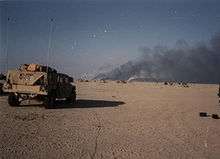
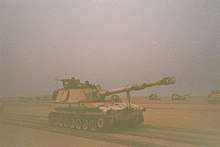

Counter reconnaissance operations
Shortly after arrival in theatre Task Force 1-41 Infantry received a counter reconnaissance mission.[4] This generally includes destroying or repelling the Iraqi's reconnaissance elements and denying their commander any observation of friendly forces. 1-41 Infantry was assisted by the 1st Squadron, 4th Cavalry Regiment. This joint effort would become known as Task Force Iron.[16] On 15 February 1991 4th Battalion of the 3rd Field Artillery Regiment, fired on a trailer and a few trucks in the Iraqi sector that was observing American forces.[17] On 16 February 1991 several groups of Iraqi vehicles appeared to be performing reconnaissance on the Task Force and were driven away by fire from 4-3 FA.[18]
That same evening an Iraqi platoon, including six vehicles, was reported as being to the northeast of the Task Force. They were engaged with artillery fire from 4-3 FA.[19] Later that evening another group of Iraqi vehicles was spotted moving towards the center of the Task Force. The vehicles appeared to be Iraqi Soviet made BTRs and tanks. Task Force 1-41 Infantry fired TOW missiles at the Iraqi formation destroying one tank. The rest of the formation was destroyed or driven away by artillery fire from 4-3 FA.[20] For the next hour the Task Force would fight several small battles with Iraqi reconnaissance units. On 17 February 1991 the Task Force took enemy mortar fire, and the Iraqi forces managed to escape.[21] Later that evening the Task Force received enemy artillery fire but suffered no casualties.[22]
Breaching operations
Task Force 1-41 Infantry was the first coalition force to breach the Saudi Arabian border on 15 February 1991 and conduct ground combat operations in Iraq engaging in direct and indirect fire fights with the enemy on 17 February 1991.[2] Prior to this action the Task Force's primary fire support battalion 4th Battalion of the 3rd Field Artillery Regiment participated in a massive artillery preparation. Around 300 guns from multiple nations participated in the artillery barrage. Over 14,000 rounds would be fired during these missions. M270 Multiple Launch Rocket Systems contributed an additional 4,900 rockets fired at Iraqi targets.[23] Iraq lost close to 22 artillery battalions during the initial stages of this barrage.[24] This would include the destruction of approximately 396 Iraqi artillery pieces.[25] By the end of these raids Iraqi artillery assets had all but ceased to exist. One Iraqi unit that was totally destroyed during the preparation was the Iraqi 48th Infantry Division Artillery Group.[26] The group's commander stated his unit lost 83 of its 100 guns to the artillery preparation.[26] This artillery prep was supplemented by air attacks by B-52 bombers and Lockheed AC-130 fixed wing gunships.[27]
Once into Iraqi territory Task Force 1-41 Infantry encountered multiple Iraqi defensive positions and bunkers. These defensive positions were occupied by a brigade-sized element.[28] Task Force 1-41 Infantry elements dismounted and prepared to engage the enemy soldiers which occupied these well-prepared and heavily fortified bunkers.[28] The Task Force found itself engaged in six hours of combat in order to clear the extensive bunker complex.[28] The Iraqis engaged the Task Force with small arms fire, RPGs, mortar fire, and what was left of Iraqi artillery assets. A series of battles unfolded which resulted in heavy Iraqi casualties and the Iraqis being removed from their defensive positions with many becoming prisoners of war. Some escaped to be killed or captured by other coalition forces.[29]
In the process of clearing the bunkers Task Force 1-41 captured two brigade command posts and the command post of the Iraqi 26th Infantry Division.[30] The Task Force also captured a brigade commander, several battalion commanders, company commanders, and staff officers.[30] As combat operations progressed Task Force 1-41 Infantry engaged at short range multiple dug in enemy tanks in ambush positions.[1] For a few hours, bypassed Iraqi RPG equipped anti-tank teams, T-55 tanks, and dismounted Iraqi infantry fired at passing American vehicles, only to be destroyed by other US tanks and fighting vehicles following the initial forces.[31]
Combat
On 17 February 1991 Task Force 1-41 Infantry engaged an Iraqi mortar position with direct and indirect fires.[32] The Task Force served at the Battle of 73 Easting with the 1st Infantry Division (Mechanized) along with the 2nd Armored Cavalry Regiment.[33] They were responsible for destroying the Iraqi 18th Mechanized and 9th Armored Brigades of the Republican Guard Tawakalna Mechanized Infantry Division and the Iraqi 26th Infantry Division.[34] The Tawakalna Republican Guard Division was Iraq's most powerful division which included approximately 14,000 soldiers, 220 T-72 tanks, 284 infantry fighting vehicles, 126 artillery pieces, and 18 MLRS.[35] On the eve of 26–27 February 1991 the Task Force destroyed elements of the Iraqi 12th Armored Division. This was a slow moving division that lacked the capability for modern day armored warfare.[36] Some 40 Iraqi tanks were destroyed and a similar number of other combat vehicles.[37] In moving to and through the Battle of 73 Easting, 2nd ACR and the 1st Infantry division's lead brigades, which included Task Force 1-41, destroyed 160 tanks, 180 personnel carriers, 12 artillery pieces and more than 80 wheeled vehicles, along with several anti-aircraft artillery systems during the battle.[38][9]
During the early stages of the Battle of Norfolk American artillery and MLRS units conducted fire missions against Iraqi targets a dozen miles to the east.[39] Two American Bradley Infantry Fighting Vehicles were destroyed by the Iraqi Republican Guard 18th Mechanized Brigade while conducting forward reconnaissance.[40] On 27 February 1991 Task Force 1-41 Infantry destroyed an Iraqi T-55 tank battalion that ambushed the Task Force.[41] The Iraqi tank unit managed to destroy a Bradley Fighting Vehicle and killed three soldiers belonging to the task force.[42] On 27 February Task Force 1-41 Infantry also destroyed an Iraqi RPG team, machine gun nest, and a bunker.[42] On 27 February 1991 Task Force 1-41 destroyed an Iraqi tank unit at great range at Objective Denver.[43] The 2nd Armored Division(Fwd) continued to fight a series of short, sharp battles with Iraqi tank platoons as it moved across the Wadi Al-Batin into Kuwait.[44] On 27 February 1991, the 2nd Armored Division (Forward) destroyed 60 Iraqi tanks and 35 infantry vehicles along the Iraq Pipeline to Saudi Arabia (IPSA).[45]
On 27 February 1991 an Iraqi tank unit attacked Battery C, 4-3 FA.[44] The Iraqi tank unit was destroyed by a Task Force 1-41 tank platoon that was assigned to protect Battery C, 4-3 FA.[44] A reconnaissance party from Battery C, 4-3 FA mistakenly moved well forward of the other Task Force 1-41 Infantry units. Task Force 3-66 Armor was given the assignment of looking for the lost reconnaissance party. As Task Force 3-66 Armor approached the reconnaissance party, enemy infantry foolishly took it under fire from fighting positions near the disoriented recon party. TF 3-66 M1A1 Abrams tanks and Bradley infantry fighting vehicles fought back with only machine guns rather than cannons to reduce the danger of hitting TF 1-41 IN, which stood just beyond the enemy. TF 3-66 AR machine gun fire drove the enemy right into TF 1-41 IN with Hillman's troops capturing all of the enemy soldiers. TF 3-66 AR recovered the members of the lost reconnaissance party unharmed.[15]
In the thick of the fog of war, U.S. units became mixed with Iraqi units dispersed throughout the desert. This confusion led to some friendly fire incidents.[46] Task Force 1-41 Infantry was involved in the worst US "friendly fire" incident of the Gulf War on 27 February 1991.[47] The Task Force also captured hundreds of Iraqi soldiers and destroyed 10 artillery pieces.[1]
Before the end of combat operations the Task Force would engage a total of 8 Iraqi divisions and multiple brigades. This included a significant role in the destruction of four Iraqi armored or mechanized brigades at the Battle of Norfolk.[48] Task Force 1-41 Infantry would capture over 300 enemy prisoners.[2] The Task Force suffered 32[49] casualties and around a dozen combat vehicles were destroyed, including five M1A1 Abrams tanks, during combat operations.[50][51] The Task Force would travel over 124 miles (200 km) in 72 hours during Operation Desert Storm.[2] Task Force 1-41 Infantry earned a Valorous Unit Award for its efforts.[2] The Valorous Unit Award is the second highest unit decoration which may be bestowed upon a U.S. Army unit.

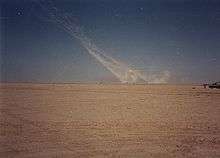
Valorous Unit Award citation
For extraordinary heroism in action against an armed enemy. Task Force 1-41 was the first coalition force to breach the Saudi Arabian border on 15 February 1991 and conduct ground combat operations in Iraq engaging in direct and indirect fire fights with the enemy on 17 February 1991. The Task Force was part of the VII Corps main attack beginning 24 February 1991 as it conducted a forward passage through 1st Infantry Division elements and began a mission to clear a zone which again resulted in enemy contact. On 26 February, following a 60 kilometer road march, the Task Force immediately engaged in ground combat with armored and dismounted enemy of brigade size. For six hours it was involved in continuous combat with a tenacious and determined enemy occupying extremely well prepared and heavily fortified bunkers. Task Force infantry elements dismounted and engaged the enemy in numerous short range fire fights while methodically clearing the extensive bunker complex. By morning the Task Force had systematically reduced the entrenched enemy positions in zone. Continuing as part of the VII Corps attack the Task Force travelled 85 kilometers in less than 24 hours while engaging at short range multiple, dug in enemy tanks in ambush positions. The Task Force reached its final objective 28 February 1991 with a push which continued the destruction of enemy armored vehicles. During the entire ground campaign, involving their attack through Iraq into Kuwait, Task Force 1-41 travelled over 200 Kilometers in 72 hours and destroyed 65 armored vehicles and 10 artillery pieces, while capturing over 300 enemy prisoners.[1]
See also
References
- VUA Citation.
- VUA Citation
- The Road to Safwan: The 1st Squadron, 4th Cavalry in the 1991 Persian Gulf War
- Hillman 1993, p. 6.
- Hillman 1993, pp. 5–6
- Dinackus 2000, p. 4A8
- US Army Center of Military History DA GO 1991-20
- Hillman P. 5-6
- Dinackus P.4–10
- Hillman P. 6
- Hillman 1993, p. 4.
- Hillman 1993, pp. 4–6.
- Hillman 1993, pp. 5–6.
- Alpha 525 Gulf War incident.
- Fontenot P.294
- Bourque and Burdan p.95
- The Road to Safwan: The 1st Squadron, 4th Cavalry in the 1991 Persian Gulf War by Bourque P.96
- The Road to Safwan: The 1st Squadron, 4th Cavalry in the 1991 Persian Gulf War by Bourque P.98
- The Road to Safwan: The 1st Squadron, 4th Cavalry in the 1991 Persian Gulf War by Bourque P.99
- The Road to Safwan: The 1st Squadron, 4th Cavalry in the 1991 Persian Gulf War by Bourque P. 99
- The Road to Safwan: The 1st Squadron, 4th Cavalry in the 1991 Persian Gulf War by Bourque P.102
- The Road to Safwan: The 1st Squadron, 4th Cavalry in the 1991 Persian Gulf War by Bourque P.103
- Jayhawk! The 7th Corps in the Persian Gulf War by Bourque P.164
- Jayhawk! The 7th Corps in the Persian Gulf War by Bourque P.161
- Jayhawk! The 7th Corps in the Persian Gulf War by Bourque P.161
- "The Gulf War and "European Artillery" - The Campaign for the National Museum of the United States Army". Armyhistory.org. 20 January 2015. Retrieved 26 November 2017.
- Jayhawk! The 7th Corps in the Persian Gulf War by Bourque pp.163
- Desert Storm/Shield Valorous Unit Award Citations
- Bourque, pp.113-133
- Bourque P.259
- "CORRECTING MYTHS ABOUT THE PERSIAN GULF WAR: THE LAST STAND OF THE TAWAKALNA". Usdefensewatch.com. 30 April 2015. Retrieved 26 November 2017.
- Bourque P.159
- Bourque P.325-337
- Bourque P.285,325-337
- Bourque P.324
- Bourque P.243
- Westwell 2001, p. 88.
- Houlahan 1999, p. 332.
- Bourque P.332
- Zaloga P.64
- Bourque P.334,335
- Bourque P.335
- Bourque P.372
- Bourque P.375
- Zaloga 2009, p. 64.
- Bourque, p.100
- Burns
- Bourque P.337
- Bourque P.336
- "Archived copy". Archived from the original on 2007-02-07. Retrieved 2016-07-05.CS1 maint: archived copy as title (link)
- Guardia p.71
Bibliography
- "Alpha 525 Gulf War Incident". Retrieved 26 December 2014.
- Department of the Army General Order 1991-20 (PDF). Washington, D.C.: US Army Center of Military History. 1991. Retrieved 7 February 2015.
- "Desert Storm/Shield Valorous Unit Award Citations". Washington, D.C.: US Army Center of Military History. Retrieved 26 December 2014.
- Bourque, Stephen A. (2001). Jayhawk! The 7th Corps in the Persian Gulf War. Washington, D.C.: US Army Center of Military History. LCCN 2001028533. OCLC 51313637.CS1 maint: ref=harv (link)
- Bourque, Stephen A.; Burdan, John (2007). The Road to Safwan: The 1st Squadron, 4th Cavalry in the 1991 Persian Gulf War. Denton, Texas: University of North Texas Press. ISBN 9781574412321.
- Burns, Robert (12 November 1991). "Worst Friendly Fire Case Tied to Thermal Sights of Tanks". AP News Archive. Associated Press. Retrieved 26 December 2014.CS1 maint: ref=harv (link)
- Dinackus, Thomas D. (2000). Order of Battle: Allied Ground Forces of Operation Desert Storm. Central Point, Oregon: Hellgate Press. ISBN 1-55571-493-5.CS1 maint: ref=harv (link)
- Hillman, James L. (1993). "Task Force 1-41 Infantry: The Fratricide Experience in Southwest Asia" (PDF). Carlisle Barracks, PA: US Army War College. OCLC 28169776. Retrieved 26 December 2014.CS1 maint: ref=harv (link)
- Houlahan, Thomas (1999). Gulf War: The Complete History. New London, NH: Schrenker Military Publishing. ISBN 9780966845600.CS1 maint: ref=harv (link)
- Scales, Robert H. (1993). Certain Victory: The U.S. Army in the Gulf War (PDF). Fort Leavenworth: U.S. Army Command and General Staff College Press. OCLC 78302979. Retrieved 26 December 2014.CS1 maint: ref=harv (link)
- Westwell, Ian (2001). 1st Infantry Division 'Big Red One'. Spearhead #6. Hersham, Surrey: Ian Allan. ISBN 9780711029231.CS1 maint: ref=harv (link)
- Zaloga, Steven J. (2009). M1 Abrams vs T-72 Ural: Operation Desert Storm 1991. Oxford, NY: Osprey. ISBN 9781846034077.CS1 maint: ref=harv (link)
- The First Infantry Division and the U.S. Army Transformed: Road to Victory in Desert Storm, 1970-1991 by Gregory Fontenot